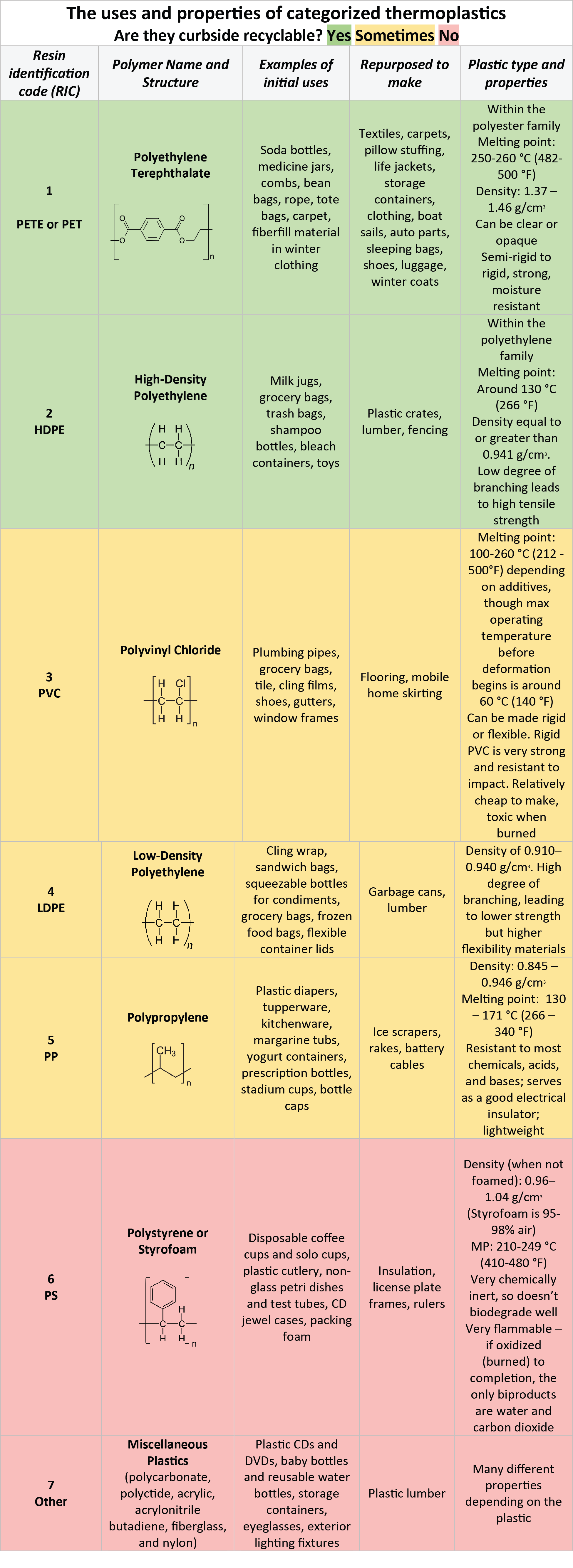By Candice Crilly
Derived from the Greek word plastikos meaning “capable of being shaped or molded”, plastic is an umbrella term used worldwide to describe synthetic or semi-synthetic polymers (i.e. long chains of repeating chemical units) that can be molded into everlasting shapes. The world’s first exposure to the promise of plastics occurred at the 1862 Great International Exhibition in London in the form of Parkesine, a material made from the plant fiber cellulose. Just over 50 years later, the first fully synthetic plastic known as Bakelite was synthesized from the two small molecules phenol and formaldehyde. From there, research into the production and properties of synthetic plastics expanded rapidly, leading to the many forms of plastic we use today (see the table below)!

The ups and downs of plastic use
Plastics are durable and lightweight, produced at a relatively low cost, and sometimes have the potential to be melted down and recast into new products (recycled). This explains why certain plastics quickly became the most common packaging materials in the world.
The rise of plastics has benefited the world in many ways; for example, plastic packaging has made it a lot easier to maintain the sterility of medical devices such as syringes and IVs by making single-use syringes cost-effective, and plastics have also have served as lightweight alternatives in the construction of automobiles, which in turn reduces fuel consumption.
Despite their practicality though, most common plastics are made from nonrenewable resources such as natural gas, meaning they often take a fair amount of energy and resources to produce. Moreover, because plastics biodegrade very slowly, there is an enormous buildup of plastic pollution in landfills and in all of Earth’s oceans. Plastic pollution has become a worldwide problem due to the rise in single-use plastics on the consumer market in the form of single-use water bottles and other convenience items. And while a large subset of plastics, known as thermoplastics, could theoretically be diverted away from landfills and instead recycled, the process of separating and cleaning some forms of used plastic poses a logistical nightmare (especially the plastics highlighted in red in the table above). Due to this lack of plastic recycling, a gargantuan amount of recoverable energy is lost and pollution created every day. It’s as clear as acrylic (a plastic even clearer than glass)– there’s a dire need for new initiatives geared toward easing the logistical strain of recycling plastics and the development of more sustainable, biodegradable plastics.
Innovative approaches toward repurposing and reducing plastic waste
But it’s not all doom and gloom. Across the world, scientists, companies, policy makers, and individuals like you and I are taking steps toward making plastics more recyclable and reducing our plastic footprint. For example, packaging-free stores are becoming more common across Europe and North America, and there are several cities in the United States that are installing “reverse vending machines” to make it more convenient and cash-incentivized for people to recycle their plastic bottles. Researchers are developing new biodegradable plastics, ways to turn used plastics into fuel, and ways to break down existing plastic waste with the help of specially-evolved bacteria. As individuals, some of the easiest ways we can shrink our plastic footprint include switching to reusable bags and containers and by voting for ballot initiatives aimed at reducing plastic waste.
Click the links here to learn more about: Polyethylene Terephthalate, High-Density Polyethylene, Polyvinyl Chloride, Low-Density Polyethylene, Polystyrene, tensile strength
Edited by Tim Daugird and Laetitia Meyrueix

